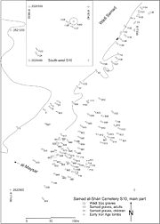
Samad al-shan
Encyclopedia

Oman
Oman , officially called the Sultanate of Oman , is an Arab state in southwest Asia on the southeast coast of the Arabian Peninsula. It is bordered by the United Arab Emirates to the northwest, Saudi Arabia to the west, and Yemen to the southwest. The coast is formed by the Arabian Sea on the...
in the Sharqiyah province where Late Iron Age remains were first identified, hence the Samad Period/Culture or assemblage. The site was discovered by surveyors from Harvard University (1971). It is located 2 km east of al-Maysar(al-Moyassar). The excavation of this site (1981-1982, 1987-1998) by Burkhard Vogt, Gerd Weisgerber
Gerd Weisgerber
Gerd Weisgerber was an eminent German professor of mining archaeology. He was one of the first mining archaeologists of the world, who set standards in this scientific discipline...
and Paul Yule of the German Mining Museum, Bochum and later University of Heidelberg documented some 260 graves which span the Bronze Age
Bronze Age
The Bronze Age is a period characterized by the use of copper and its alloy bronze as the chief hard materials in the manufacture of some implements and weapons. Chronologically, it stands between the Stone Age and Iron Age...
to Late Iron Age in the Sultanate of Oman. Samad is the type-site for the non-writing Late Iron Age of south-eastern Arabia, that is Central Oman. It is preceded by the Early Iron Age which differs somewhat in terms of pottery from that distriubtged in the neighbouring present-day United Arab Emirates.
The remains of different pre-Islamic periods exist at Samad. The Samad Late Iron Age dates from c. 250 BCE to c. 400 CE. Other artefact assewmblages exist parallel to it.

